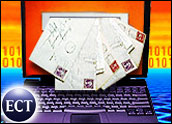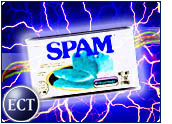
Numerous products and services are now available to shield consumers and businesses from the ever-increasing barrage of spam. But experts warn that no service can possibly keep out all the junk and say that if users are not careful, they could end up blocking some mail that they actually might want.
“What’s spam to you could be useful company information to someone else,” Gartner research director Maurene Caplan Grey told the E-Commerce Times.
Nevertheless, she noted, e-mail users are being inundated with 10 times the spam they were receiving just a year ago, and 16 times what they were getting two years ago.
Brightmail Leads
According to Grey, a number of companies offer effective weapons. The field is led by Brightmail, which sells products and services that keep out spam in two ways: by identifying words used frequently in the subject lines of unwanted mail and by “blacklisting” the mailbox addresses of frequent spammers.
Other spam-fighting agents, Grey added, are sold by Elron, Tumbleweed and SRA.
Specifically, these companies provide content-screening products that monitor incoming and outgoing correspondence to ensure that company policies and procedures are being followed.
Spam and content filtering are also in the arsenals of security suites provided by firms like TruSecure, Symantec and McAfee.
When programmed correctly and updated frequently, experts said, these offerings can be highly effective at fighting spam. But even as these products get better at keeping out junk e-mail, Grey noted, they cannot be expected to predict every trick that spammers might invent to evade message filters.
Programs Have Limits
Blacklist programs, which identify spammers by their IP address, can be thwarted by spam senders who switch mailboxes frequently. Keyword finders can be foiled by mailers who disguise their messages with legitimate-looking subject lines.
Even market leader Brightmail has just an 80 percent filtering rate, meaning a considerable amount of spam still gets through, Grey said.
In addition, filters sometimes do their jobs too well, according to analysts, blocking out vital correspondence at inopportune moments.
Grey cited the example of a company that gave an important internal project a name that happened to be on the word-blocking list of the company’s spam filter. At a crucial point in the project, employees were unable receive to e-mail related to the project.
“It’s a tricky business,” Grey said. “You’re always in a situation where you’re asking yourself if you are blocking the right things or not.”
Rethinking Strategies
While current anti-spam technology is highly effective, it forces commerce and marketing firms to rethink how they do business, Aberdeen Group research director Kent Allen told the E-Commerce Times.
“The companies using these programs are causing other people to alter their marketing programs and strategies,” Allen said. “Some of these filters block out legitimate e-mail within companies.”
Still, experts said, the overall investment in spam-blocking is well worth it for business operators. Spam is not only an annoyance, it also drains productivity and leaves companies open to threats, such as well-disguised denial-of-service attacks.
Allen said the pesky problem of spam will never be completely eliminated, no matter how smart technology gets.
“There’s only so much these services can do,” he noted. “No matter what you try to do, some cockroaches will always be coming at you.”
























































Social Media
See all Social Media